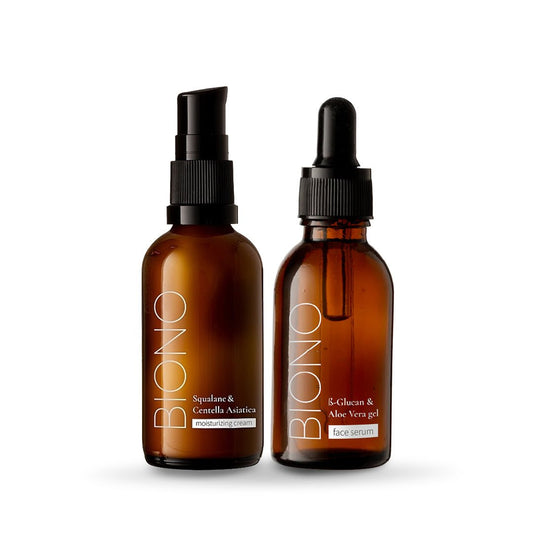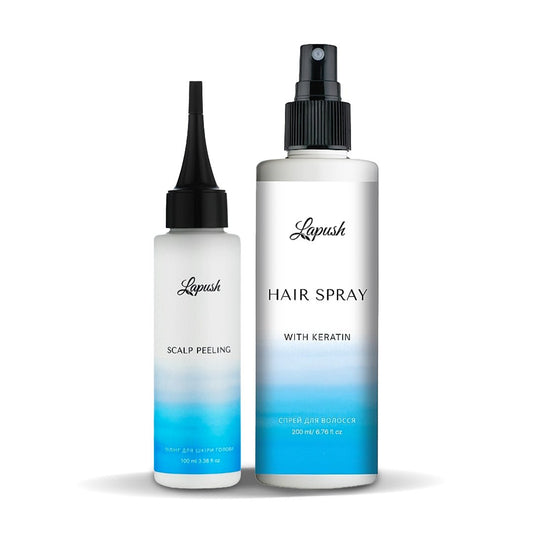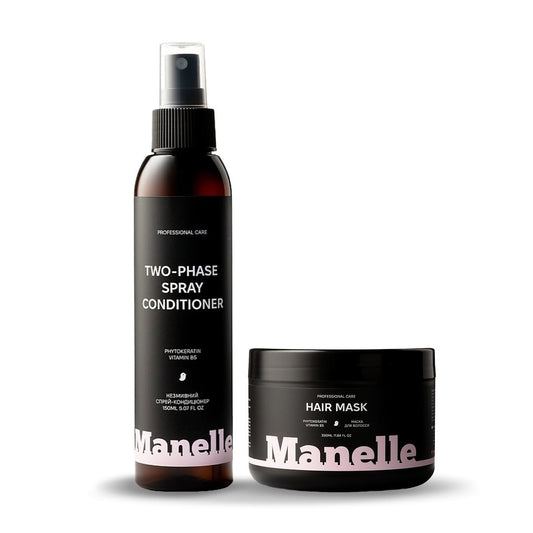
How to care for dehydrated, sensitive and mature skin: a comprehensive approach
Modern lifestyle, environmental factors and natural aging processes create unique challenges for our skin. Dehydrated, sensitive and mature skin requires a special approach and carefully selected care products. Understanding the characteristics of each skin type helps to create an effective routine that restores natural balance, soothes irritations and fights signs of aging. The right choice of cosmetic products can radically change the condition of your skin, returning it to a healthy appearance, elasticity and natural radiance.
Features of caring for dehydrated skin: restoring water balance
Dehydrated skin differs from dry skin in that it lacks water, not lipids. This condition can occur in any skin type - from oily to dry. The main signs of dehydration are a feeling of tightness, fine lines, a dull complexion and increased sensitivity to external factors. The skin may look flabby and lose its natural elasticity.
To restore water balance, it is necessary to use products with hyaluronic acid , which is able to hold water 1000 times its own weight. Serums and creams with this component provide deep hydration at the cellular level. It is also important to include products with ceramides in the care, which strengthen the skin's protective barrier and prevent moisture loss.
A daily routine for dehydrated skin should include gentle cleansing without harsh sulfates, using an alcohol-free toner, and applying moisturizer twice a day. Don't forget to moisturize with masks and intensive serums 2-3 times a week. It's also important to maintain optimal humidity levels in the room and drink plenty of water throughout the day.
Sensitive skin care: softness and delicacy at every step
Sensitive skin reacts to the slightest irritants - changes in temperature, cosmetics, stress or even touch. It is prone to redness, burning, itching and rashes. This type of skin requires a particularly delicate approach and the use of hypoallergenic products with a minimum amount of active ingredients.
The basis of sensitive skin care is the principle of "less is more". Choose products with a simple composition, without perfumes, dyes and aggressive preservatives. Products with soothing ingredients will be especially useful: aloe vera, chamomile, centella asiatica, niacinamide. These ingredients reduce inflammation, soothe irritation and strengthen the skin's protective functions.
When choosing products for sensitive skin, be sure to do a patch test before first use. Apply a new product to a small area of skin and observe the reaction for 24-48 hours. Avoid multi-step procedures and frequent changes in care products. A stable, simple routine with proven products is the key to healthy sensitive skin.

Anti-aging products for mature skin: fighting against time
Mature skin is characterized by a decrease in collagen and elastin production, the appearance of wrinkles, loss of elasticity and even tone. After 25 years, regeneration processes slow down, so it is important to support the skin with active anti-aging components. Retinol, peptides, vitamin C and antioxidants become indispensable allies in the fight against the signs of aging.
Retinol remains the gold standard in anti-aging care. It stimulates cell turnover, smoothes wrinkles, and improves skin texture. Start with low concentrations of 0.25-0.5% and gradually increase, using only in the evening. Be sure to combine retinol with sunscreen during the day, as it increases skin photosensitivity.
Peptides are molecules that stimulate collagen synthesis and support skin structure. They are gentler than retinol, so they are suitable even for sensitive skin. Vitamin C in a stable form protects against free radicals and lightens age spots. A comprehensive approach using various active ingredients gives the best result in the fight against age-related changes.
Selection of products for oily and combination skin: balance without overdrying
Oily skin is characterized by increased activity of the sebaceous glands, enlarged pores and a tendency to acne. Combination skin combines the signs of oily in the T-zone (forehead, nose, chin) and normal or dry on the cheeks. The main mistake in caring for such skin types is trying to "dry" it out with aggressive products, which leads to the opposite effect and increased sebum production.
For oily and combination skin, it's important to find a balance between sebum control and adequate hydration. Use gentle cleansing gels with salicylic acid or benzoyl peroxide to prevent inflammation. Light, non-comedogenic, water-based moisturizers will provide the necessary hydration without clogging pores. Clay masks 1-2 times a week will help to deeply cleanse pores and mattify the skin.
Niacinamide is becoming an indispensable component for oily skin care. It regulates the work of the sebaceous glands, tightens pores and has an anti-inflammatory effect. Zinc also effectively fights acne and reduces oiliness. It is important not to forget about sun protection, even if the skin is oily - UV rays can increase inflammation and pigmentation.
Special care for dry skin: intensive nourishment and protection
Dry skin lacks both water and lipids. It often feels tight, flaky, may have a grayish tint and wrinkle early. This type of skin requires intensive nutrition and restoration of the protective lipid barrier. The basis of care is rich textures with occlusive and emollient components.
Oils and butters become the best friends of dry skin. Argan, jojoba, shea and squalane deeply nourish and restore barrier function. Use them both separately and as part of creams and serums. Hyaluronic acid in combination with occlusive components will provide long-lasting hydration. Urea and lactic acid in low concentrations will help gently exfoliate dead skin cells.
For dry skin, a proper cleansing regimen is especially important. Avoid hot water and harsh products with sulfates. Choose mild cleansing milks or hydrophilic oils. After cleansing, be sure to use a nourishing alcohol-free toner and apply a rich cream to still damp skin. Additional nourishing masks 2-3 times a week will maintain optimal moisture levels.
Cosmetics with prebiotics: supporting the natural skin microbiome
Prebiotics in cosmetics are an innovative approach to care based on supporting beneficial skin microflora. The skin microbiome consists of billions of microorganisms that protect against pathogens, maintain pH balance and promote regeneration. Disruption of this balance leads to inflammation, increased sensitivity and premature aging. Prebiotics create a favorable environment for the reproduction of beneficial bacteria.
The main prebiotic components in cosmetics are inulin, fructooligosaccharides, alpha-glucan oligosaccharide and xylitol. These substances nourish beneficial microflora and inhibit the growth of pathogenic microorganisms. Products with the Aquaxyl complex, which combines prebiotic action with intensive moisturizing, are especially effective. Regular use of prebiotic cosmetics strengthens the protective barrier and increases the skin's resistance to external factors.
Prebiotics are especially beneficial for sensitive and mature skin, as the microbiome becomes less diverse with age. They help restore the natural balance without aggressive intervention. Products with prebiotics gently regulate sebum production, reduce inflammation and accelerate the healing of microtraumas. It is important to combine prebiotic cosmetics with gentle cleansing so as not to disrupt the established balance of microflora.

Postbiotics in cosmetology: fermented ingredients for skin health
Postbiotics are metabolic products of beneficial bacteria that have direct benefits for the skin. Unlike probiotics (live bacteria), postbiotics are stable in cosmetic formulas and do not require special storage conditions. Fermented extracts, peptides and organic acids formed during the fermentation process have powerful biological activity and easily penetrate the skin.
The most popular postbiotic ingredients are fermented rice, soy, algae and Lactobacillus lactic acid bacteria. The fermentation process breaks down large molecules into smaller ones, increasing their bioavailability. Fermented rice extract is rich in B vitamins, amino acids and antioxidants that brighten the skin and stimulate regeneration. Lactobacillus produces lactic acid, which gently exfoliates and moisturizes.
Postbiotics are extremely effective for mature skin, as they stimulate the synthesis of collagen and elastin. Fermented peptides penetrate deeper than usual and have a more active effect on the recovery processes. For sensitive skin, postbiotics are an ideal choice due to their mildness and hypoallergenicity. They soothe inflammation, strengthen the protective barrier and increase the skin's immunity at the cellular level.
Seasonal Skin Care: Adapting Your Routine to Weather Changes
The skin reacts to seasonal changes as sensitively as our entire body. In summer, increased humidity and UV radiation require light textures with high SPF, while winter frosts and dry air from heating create the need for intensive nutrition. The transitional seasons - spring and autumn - are the best time to introduce active ingredients and conduct course treatments.
Spring skin detoxification includes gentle acid exfoliation to remove dead skin cells accumulated over the winter and prepare for the summer sun. It is in spring that you should start a course with vitamin C and antioxidants. Summer care focuses on protection and light hydration - gel textures with hyaluronic acid and mandatory SPF 30+ even in cloudy weather.
Autumn is the perfect time to introduce retinol and other active ingredients, as solar activity decreases. It is in autumn that the skin best perceives intensive procedures and recovers faster. Winter care requires rich creams with ceramides and natural oils that will protect against frostbite and dryness. Do not forget about the humidifier in the heating season - it will become an indispensable assistant in maintaining skin hydration.
Multimasking: a personalized approach to different areas of the face
Combination skin and localized problems require a differentiated approach - this is where the multi-masking technique comes in. This method involves using different masks simultaneously on different areas of the face according to their specific needs. The T-zone may need a deep cleansing with a clay mask, while the cheeks respond better to a hydrating alginate mask.
For effective multi-masking, it is important to accurately identify problem areas. The eye area always needs delicate products with peptides and caffeine to combat puffiness and dark circles. The forehead and nose, which are prone to blackheads, are best treated with a mask with activated charcoal or BHA acids. Cheeks and chin may need soothing masks with aloe or centella asiatica.
The optimal frequency of multi-masking is 1-2 times a week, the duration of the procedure is 15-20 minutes. Start with thorough cleansing, apply masks in a thin, even layer, avoiding the area around the eyes and lips. Wash off the masks in the same order in which they were applied, completing the procedure with a tonic and moisturizer. Such personalized care allows you to most effectively solve local problems without affecting healthy areas of the skin.
Conclusion
Choosing the right skincare products depends on understanding your skin's individual needs. Dehydrated skin needs intense hydration with hyaluronic acid, sensitive skin needs gentle soothing formulas, mature skin needs active anti-aging ingredients. Oily and combination skin requires a balance between cleansing and moisturizing, and dry skin needs rich nourishment and protection.
Innovative prebiotics and postbiotics open up new possibilities in skin care, especially for sensitive and mature skin. They work at the microbiome level, restoring the natural balance and strengthening the protective functions. The combination of traditional active ingredients with prebiotic and postbiotic ingredients creates a synergistic effect and provides comprehensive care.
Remember that effective care is not about the quantity of products, but their quality and compliance with the needs of your skin. Gradually introduce new products, observe the reaction and adjust your routine to seasonal changes. Consulting a dermatologist or cosmetologist will help you more accurately determine your skin type and choose the optimal care program. Investing in quality products and regularity is the key to healthy and beautiful skin at any age.














